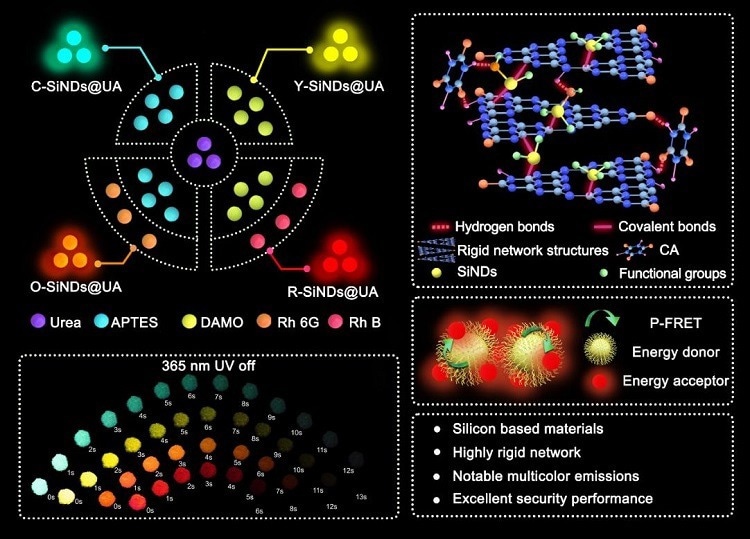There has been a lot of interest in the use of photoluminescent materials for information security. Several anti-counterfeiting technologies have been created, including luminous printing, 2D codes, and watermarks. Common fluorescent materials, however, are monochromatic and simple to counterfeit.

Schematic illustration for the preparations of C-SiNDs@UA, Y-SiNDs@UA, O-SiNDs@UA, and R-SiNDs@UA. Image Credit: SIBET
A group of scientists from the Chinese Academy of Sciences’ Suzhou Institute of Biomedical Engineering and Technology (SIBET) created a nanocomposite material with a multicolored afterglow using a simple hydrothermal method. They created Si-based phosphorescent substances using silane as a precursor and utilized them in the realm of information security.
Chemical Engineering Journal published the findings.
Due to their peculiar afterglow characteristics, materials that exhibit room-temperature phosphorescence (RTP) have been extensively exploited in lighting, bioimaging, and information security.
Conventional synthesis methods mainly use inorganic compounds containing rare earth ions or complexes with noble metals to provide afterglow, which inevitably leads to high biological toxicity and expensive syntheses.
Wenfei Dong, Study Lead Researcher and Professor, Suzhou Institute of Biomedical Engineering and Technology, Chinese Academy of Sciences
According to Dong, two conditions must be satisfied: a stable stiff structure that stabilizes the excited triplet states of the exciplexes, and effective exciplex intersystem crossing.
In light of this, the researchers decided to use 3-Aminopropyl triethoxysilane (APTES) and N-[3-(Trimethoxysilyl) propyl] ethylenediamine (DAMO) as Si sources and another precursor to creating optically stable cyan and yellow RTP materials, respectively.
A one-step hydrothermal approach is used for the preparation procedure, which not only successfully avoids the drawbacks of the two-step method but also more easily produces nanodots in situ and immobilizes them in the matrix.
This newly created anti-counterfeiting tactic can be used in situations involving higher levels of encryption where only interference information is obtained in the UV-irradiation and afterglow modes, and where the aid of a filter is necessary to correctly read the encrypted content, allowing for better concealment of the correct information.
Given the universality of this method, this standardized strategy not only highlights the potential of constructing multifunctional phosphorescent materials from silane, but also provides a novel design principle for the synthesis of full-color afterglow materials.
Dr Minghui Zan, Study Corresponding Author, Wuhan University
This study presents fresh design ideas and insights for the development of silicon-based afterglow materials for cutting-edge applications as well as proof of concept for the synthesis of multi-color phosphorescent materials utilizing silane.
The study was funded by the National Key R&D Program of China, the National Natural Science Foundation of China, and the High-level Innovation and Entrepreneurship Talent Introduction Plan of Jiangsu Province, among others.
Journal Reference
Liu, Y., et al. (2023) Multi-Color Room temperature phosphorescent Silicon-Nanodot-Based nanocomposites with silane tuning and applications to 5D information encryption. Chemical Engineering Journal. doi:10.1016/j.cej.2023.144349.